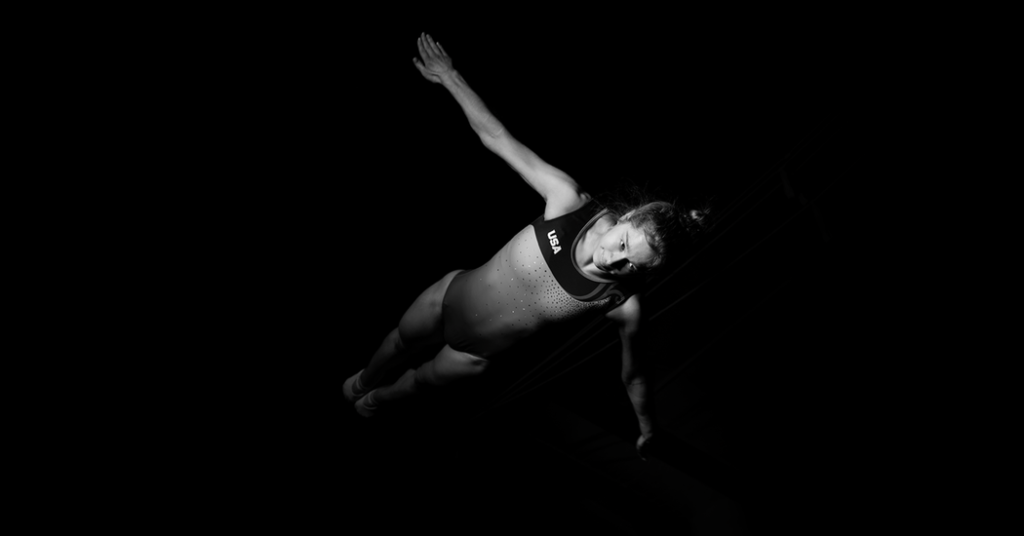For as long as I can remember, I have dreamed of competing in the Olympics. I would practice my salute in front of my bathroom mirror, pretending I was about to compete. I imagined what it would look like, what it would feel like, finishing in triumph and joy.
A trampoline routine consists of 10 tricks, each with two or three flips and countless twists and turns in between. All 10 must be performed consecutively, with precise form, no repetitions, and toes pointed.
I was obsessed with the pursuit of aerial perfection; the thrill of learning a new skill, refining it, and incorporating it into a routine was my life's purpose for almost 20 years. But as exhilarating as the skill was, it was the bounce just before it, the moment when I was fully airborne, where I found freedom.
Every performance begins with a full-speed jump. Each jump builds on the momentum of the previous one, until you rocket high into the air with so much speed and energy that even gravity can't keep up. You finally reach your peak, rising nearly 30 feet in the air and suspended for just a millisecond.
I purposefully take a breath here, letting this moment feel like a meditation, before rushing back to reality. The poet calls this a “sesura,” and by intentionally leaving a pause between the two phrases, we create a clear awareness of “before” and “after.”
Amidst the unimaginable stress of qualifying for the Olympics, I found solace in the feeling of floating.
At the 2016 Olympic Trials, I placed first in singles. There was an opening in the girls trampoline section. I was one month away from the competition I'd dreamed of since I was six years old. I remember thinking that by this time tomorrow, I might finally be an Olympian.
During my last training session, I started doing regular jumps, aiming for that peak I love. The moment my feet left the trampoline bed, I knew I had miscalculated. When I reached the peak of the jump, it was as if time had stopped and I was frozen like a photograph. I can still see that scene when I close my eyes.
A second and a half later, I was on the floor with a broken ankle, watching the 2016 Olympics from home.
The Olympics are tough and cruel. They don't wait until you're ready and you only get a second chance once every four years. There is bound to be joy in achieving your dreams exactly as you envisioned them, but my journey has been just that – a journey.
It's been almost eight years since I was injured and three years since I competed as an alternate at the Tokyo Olympics.
During this time of healing and reflection, I realized what a gift it is to be able to recklessly chase my dreams. In the midst of all the fear and risk, there is an extraordinary experience that can only come when you give yourself completely, knowing the heights you might fall.
I set out to photograph this year's Olympic hopefuls as an ode to this wonderful, and sometimes painful, pursuit.
Here is a group of extraordinary people, bound together by athletic tape and hope, diving in without even looking where they'll land, and while no two journeys are the same, this is their universal “Before.”
All the trampolinists competing at the U.S. Olympic Trials in Minneapolis next week have at least one thing in common: a love of the rhythmic up-and-down motion of the 10-step sequence, honed by a lifetime of practice.
When the time comes, they salute the judges and, despite their fear, jump higher and higher. Their eyes find the red “X” that marks the center of the trampoline and they hang on to it like a kite in a storm, focused on the relentless pull of gravity that pulls them down and gives them just as much of a chance to rise again.
Charlotte Drury is a Brooklyn-based photographer and speaker, and was a member of the 2020 U.S. Olympic team.
The Times is committed to publishing Diverse characters To the Editor: Tell us what you think about this article or any other article. Tips. And here is our email: letters@nytimes.com.
Follow The New York Times Opinion section Facebook, Instagram, Tick tock, WhatsApp, X and thread.

